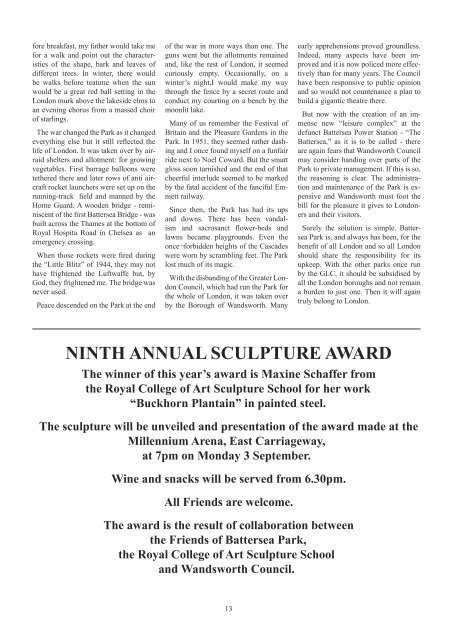Jimmy Burns - Editor Mike Bates - Production - Battersea Park
Jimmy Burns - Editor Mike Bates - Production - Battersea Park
Jimmy Burns - Editor Mike Bates - Production - Battersea Park
You also want an ePaper? Increase the reach of your titles
YUMPU automatically turns print PDFs into web optimized ePapers that Google loves.
fore breakfast, my father would take me<br />
for a walk and point out the characteristics<br />
of the shape, bark and leaves of<br />
different trees. In winter, there would<br />
be walks before teatime when the sun<br />
would be a great red ball setting in the<br />
London murk above the lakeside elms to<br />
an evening chorus from a massed choir<br />
of starlings.<br />
The war changed the <strong>Park</strong> as it changed<br />
everything else but it still reflected the<br />
life of London. It was taken over by airraid<br />
shelters and allotment: for growing<br />
vegetables. First barrage balloons were<br />
tethered there and later rows of anti aircraft<br />
rocket launchers were set up on the<br />
running-track field and manned by the<br />
Home Guard. A wooden bridge - reminiscent<br />
of the first <strong>Battersea</strong> Bridge - was<br />
built across the Thames at the bottom of<br />
Royal Hospita Road in Chelsea as an<br />
emergency crossing.<br />
When those rockets were fired during<br />
the “Little Blitz” of 1944, they may not<br />
have frightened the Luftwaffe but, by<br />
God, they frightened me. The bridge was<br />
never used.<br />
Peace descended on the <strong>Park</strong> at the end<br />
of the war in more ways than one. The<br />
guns went but the allotments remained<br />
and, like the rest of London, it seemed<br />
curiously empty. Occasionally, on a<br />
winter’s night,I would make my way<br />
through the fence by a secret route and<br />
conduct my courting on a bench by the<br />
moonlit lake.<br />
Many of us remember the Festival of<br />
Britain and the Pleasure Gardens in the<br />
<strong>Park</strong>. In 1951, they seemed rather dashing<br />
and I once found myself on a funfair<br />
ride next to Noel Coward. But the smart<br />
gloss soon tarnished and the end of that<br />
cheerful interlude seemed to be marked<br />
by the fatal accident of the fanciful Emmett<br />
railway.<br />
Since then, the <strong>Park</strong> has had its ups<br />
and downs. There has been vandalism<br />
and sacrosanct flower-beds and<br />
lawns became playgrounds. Even the<br />
once¬forbidden heights of the Cascades<br />
were worn by scrambling feet. The <strong>Park</strong><br />
lost much of its magic.<br />
With the disbanding of the Greater London<br />
Council, which had run the <strong>Park</strong> for<br />
the whole of London, it was taken over<br />
by the Borough of Wandsworth. Many<br />
13<br />
early apprehensions proved groundless.<br />
Indeed, many aspects have been improved<br />
and it is now policed more effectively<br />
than for many years. The Council<br />
have been responsive to public opinion<br />
and so would not countenance a plan to<br />
build a gigantic theatre there.<br />
But now with the creation of an immense<br />
new “leisure complex” at the<br />
defunct <strong>Battersea</strong> Power Station - “The<br />
<strong>Battersea</strong>,” as it is to be called - there<br />
are again fears that Wandsworth Council<br />
may consider handing over parts of the<br />
<strong>Park</strong> to private management. If this is so,<br />
the reasoning is clear. The administration<br />
and maintenance of the <strong>Park</strong> is expensive<br />
and Wandsworth must foot the<br />
bill for the pleasure it gives to Londoners<br />
and their visitors.<br />
Surely the solution is simple. <strong>Battersea</strong><br />
<strong>Park</strong> is, and always has been, for the<br />
benefit of all London and so all London<br />
should share the responsibility for its<br />
upkeep. With the other parks once run<br />
by the GLC, it should be subsidised by<br />
all the London boroughs and not remain<br />
a burden to just one. Then it will again<br />
truly belong to London.<br />
NINTH ANNUAL SCULPTURE AWARD<br />
The winner of this year’s award is Maxine Schaffer from<br />
the Royal College of Art Sculpture School for her work<br />
“Buckhorn Plantain” in painted steel.<br />
The sculpture will be unveiled and presentation of the award made at the<br />
Millennium Arena, East Carriageway,<br />
at 7pm on Monday 3 September.<br />
Wine and snacks will be served from 6.30pm.<br />
All Friends are welcome.<br />
The award is the result of collaboration between<br />
the Friends of <strong>Battersea</strong> <strong>Park</strong>,<br />
the Royal College of Art Sculpture School<br />
and Wandsworth Council.


